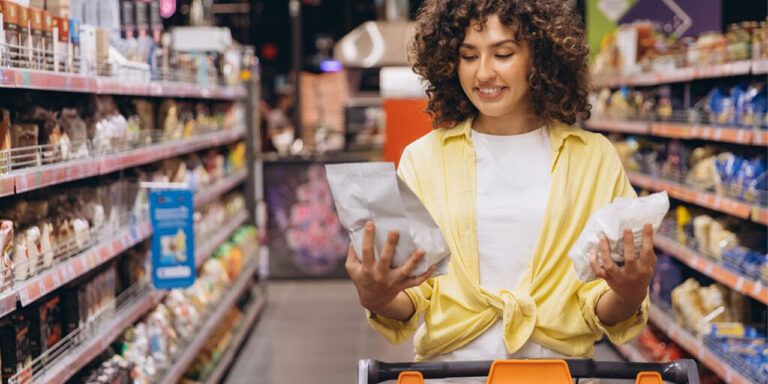Grocery shoppers expect more than ever
Today’s grocery shoppers inhabit a fluid, omnichannel world where the boundaries between online and offline shopping have essentially disappeared. This shift represents more than just technological advancement; it reflects a fundamental change in how consumers approach grocery shopping. They expect their preferred retailer to recognize them and their preferences across all touchpoints.
The challenge for grocery retailers is that this seamless experience requires unprecedented coordination across traditionally separate functions. Marketing must align with supply chain planning, store operations must sync with ecommerce fulfillment, and inventory management must account for both in-store browsing patterns and online delivery demands. When these elements work in harmony, customer loyalty and sustained growth follow. When they don’t, the consequences are swift and severe.
The competitive imperative and the cost of inaction
The grocery retailing landscape continues to evolve rapidly, and the cost of maintaining disconnected operations grows daily. Customer expectations aren’t static — they continue to rise as competitors improve their capabilities and new technologies enable better experiences.
Continued customer frustration and churn result when retailers fail to address the fundamental challenges that create disappointing shopping experiences. Customers who consistently encounter stockouts, fulfillment problems, or inconsistent experiences will eventually move on to retailers who can reliably meet their expectations.
Operational inefficiencies and waste become more costly over time as labor costs rise, margins tighten, and sustainability requirements become more stringent. Retailers who continue to rely on manual processes and disconnected systems will find themselves at increasing disadvantage.
Competitive disadvantage in the omnichannel market intensifies as leading retailers invest in integrated platforms and AI-driven capabilities. The gap between leaders and laggards widens, making it increasingly difficult for trailing retailers to catch up.
6 critical pain points destroying customer experience
Customer frustration in the grocery sector translates directly to lost loyalty and revenue. Unlike other retail categories where shoppers might tolerate occasional disappointments, grocery shopping is habitual and extremely personal. When customers can’t find their regular products or encounter inconsistent experiences, they don’t just purchase different items — they often switch retailers entirely.
In today’s interconnected grocery retail environment, customer pain points both online and in-store rarely present themselves as isolated incidents. When forecasting fails, inventory blind spots emerge. Poor visibility forces manual workarounds. Overwhelmed teams can’t execute properly. Promotions go wrong. Waste piles up. Each failure feeds the next, creating a vicious cycle that drives customers to competitors.
The good news? These six pain points share a common root cause: disconnected planning and execution. By addressing them with integrated solutions, you don’t just fix individual problems — you create the unified, intelligent system that delivers seamless customer experiences.
Let’s examine how each pain point undermines your operations and how RELEX transforms these challenges into competitive advantages.
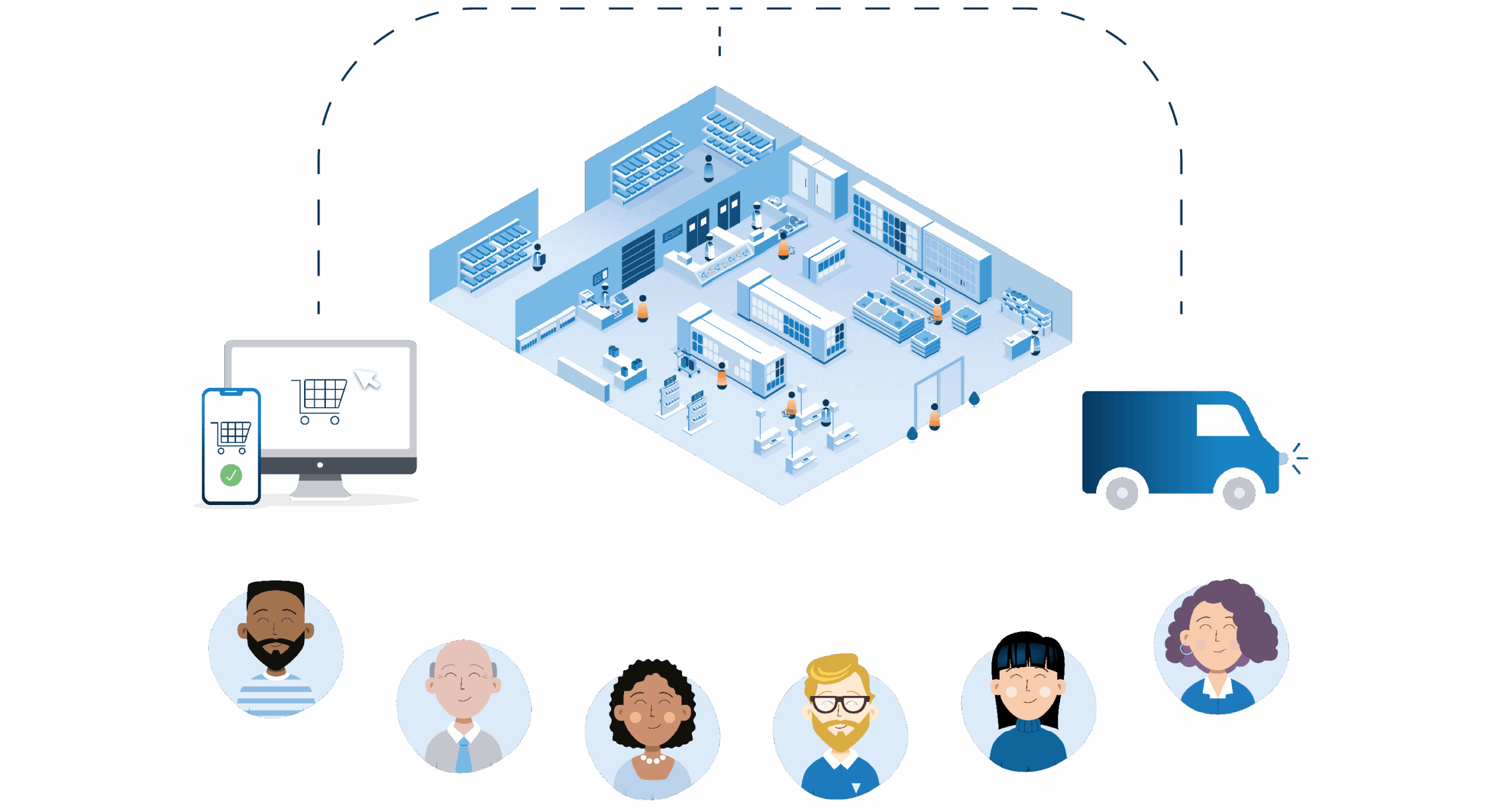
Pain point #1: “It wasn’t in stock!” – Forecasting failures across channels
A shopper’s experience: Maria

“I order groceries for my family every Sunday night, ready for a Monday pickup. When I order, the app shows everything is available. But when I arrived at the store recently, five items were missing — including my daughter’s special yogurt (her substitute has allergens) and tonight’s dinner chicken. The replacement costs $8 more.”
Persona spotlight: VP of Supply Chain

“We see Maria’s story repeated a thousand times. Forecasting online and in-store is challenging, and my team spends countless hours adjusting the forecast manually, but by the time we are done, the demand changes, and we need to start again.”
The problem and business impact
When retailers use combined forecasts for online and in-store demand, they create systematic inventory errors that directly translate to lost sales and frustrated customers. Online and in-store channels behave fundamentally differently — online shoppers might order bulk items for delivery, while in-store customers grab single units. This one-size-fits-all forecasting approach inevitably overserves one while underserving the other, causing stockouts where customers expect availability and creating inventory imbalances that hurt profitability across all channels.
From an operational perspective, forecast inaccuracy creates inventory imbalances that are expensive to correct. Overstocked items tie up working capital and drive waste— particularly for fresh products with limited shelf life — while understocked items represent lost sales opportunities that may never be recovered.
RELEX solution: Channel-specific forecasting
RELEX addresses this challenge through sophisticated channel-specific forecasting that recognizes the unique characteristics of each sales channel. The system generates intelligent forecasts for online and in-store demand while maintaining coordination through a unified platform.
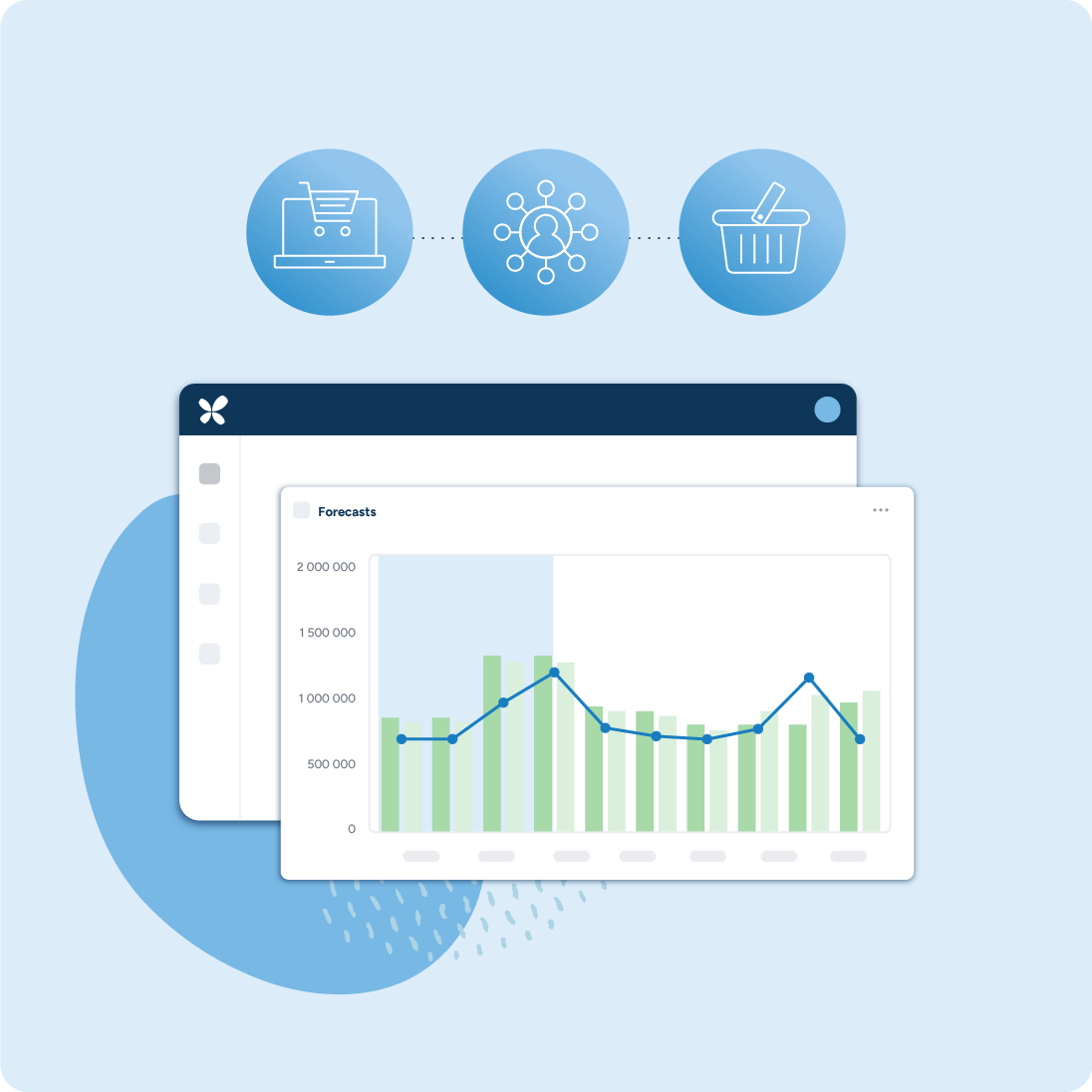
Capabilities from advanced retail omnichannel planning enhance artificial intelligence (AI)-enabled forecasting by enabling separate forecasts for in-store and online sales at the store level. This allows retailers to account for channel-specific factors such as foot traffic patterns, display effectiveness, and local demographics for in-store channels, as well as delivery time windows, batch ordering patterns, and digital marketing influences for online channels.
This approach doesn’t just improve accuracy — it enables more strategic planning. Retailers can optimize promotions for specific channels, adjust inventory positioning based on expected demand patterns, and make informed decisions about product assortment by channel.
Real-world results: ICA Sweden’s enhanced omnichannel availability
ICA Sweden’s omnichannel success demonstrates how channel-specific forecasting and unified inventory visibility eliminate the availability gaps that frustrate customers and drive them to competitors.
The Swedish grocery leader transformed their planning process from reactive firefighting to proactive optimization, enabling teams to focus on strategic growth rather than operational problems. This improvement directly translates to increased sales, stronger customer satisfaction, and lasting loyalty across all channels.
Pain point #2: “Where’s my order?” – Inventory visibility black holes
A shopper’s experience: David

“I’m busy and count on my local store to have what I need. Recently, I ordered a specific pasta for a dinner party after the app showed it was in stock. But when I arrived, I was told it wasn’t available and had been reserved for someone else. Other nearby stores were out too. With just a few hours before guests arrived, I had to scramble through three stores to find a substitute. What should’ve been a simple pickup turned into a stressful afternoon. I’m not sure I’ll shop there again.”
Persona spotlight: Head of Omnichannel Operations

“Customers like David are losing trust in our online promises, and I can’t blame them. We’re constantly firefighting stockouts and overstocks — there’s no visibility or control. We know there’s a better way, but our current systems make it impossible to get the real-time visibility we need to prevent these disasters.”
The problem and business impact
When grocery retailers operate with fragmented inventory systems and limited real-time visibility, they create experiences like David’s that cost far more than a single sale. His dinner party story, shared with eight guests, damaged the retailer’s reputation among potential high-value customers. David, who typically spends $200 weekly on groceries, now splits his shopping between the two competitors.
This visibility crisis stems from disconnected systems — different departments use separate platforms, third-party fulfillment partners operate with minimal integration, and store-level tracking relies on outdated information. Without real-time demand signals across channels, planners can’t allocate stock effectively, store managers don’t know when critical deliveries arrive, and online fulfillment teams can’t verify product availability. The result is a vicious cycle: stockouts in some locations while excess inventory spoils elsewhere, teams trapped in expensive reactive firefighting instead of proactive planning and mounting customer complaints that erode trust and loyalty.
RELEX solution: Unified inventory visibility and virtual ringfencing
RELEX provides comprehensive inventory visibility across all locations and channels in real time. The platform integrates data from stores, distribution centers, suppliers, and third-party partners to create a single, accurate view of inventory availability.
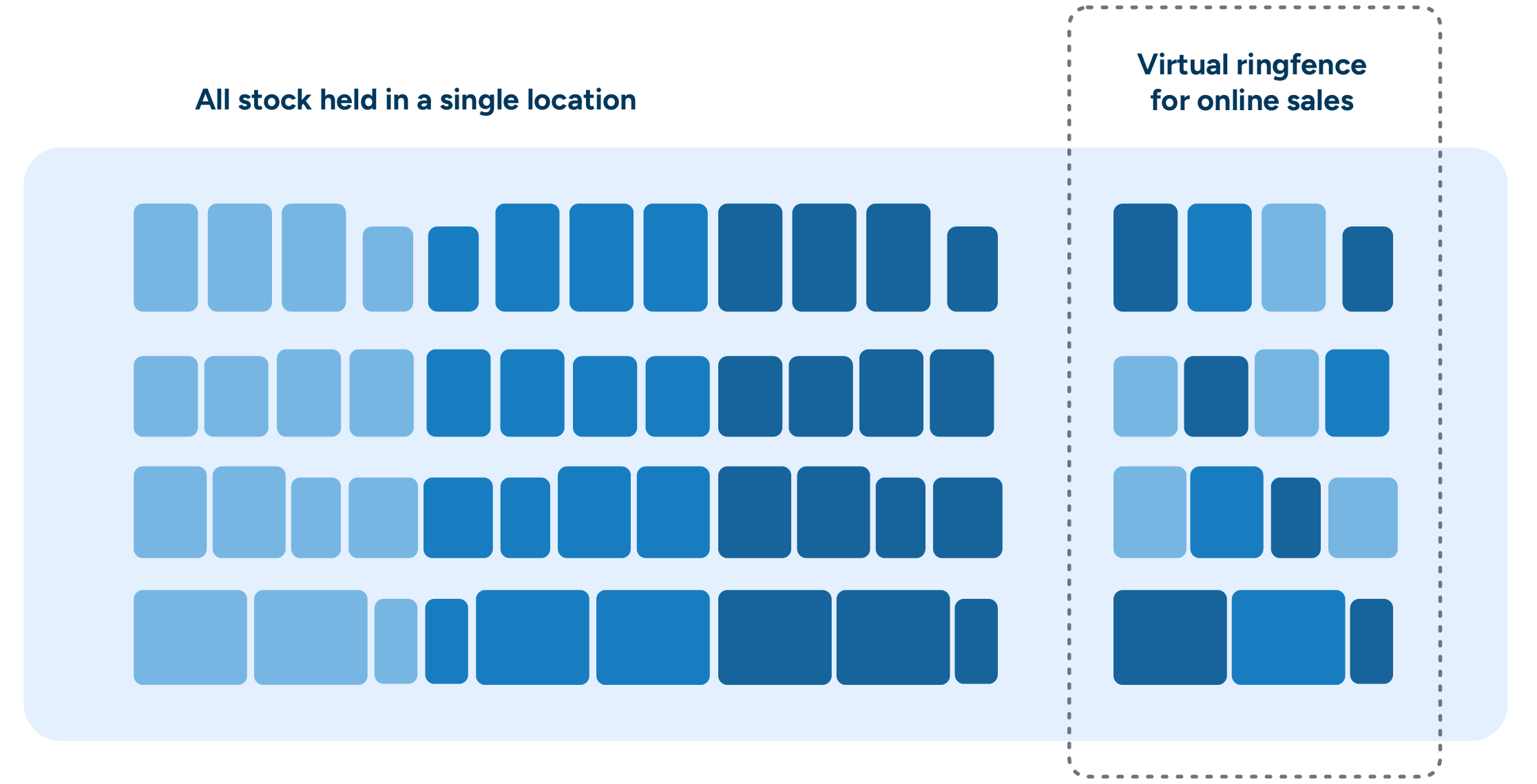
Virtual ringfencing takes this visibility a step further by intelligently protecting inventory for priority channels or high-value customers. The system can automatically reserve stock for online orders, protect inventory for upcoming promotions or ensure that key items remain available for in-store customers during peak shopping periods.
This intelligent allocation goes beyond simple rules-based systems. The AI continuously learns from demand patterns, customer behavior, and business outcomes to optimize allocation decisions dynamically. The result is better availability across all channels while reducing overall inventory investment.
Real-world results: Bünting AG
Bünting AG is a traditional family-run business located in Leer, Ostfriesland, Germany. Founded in 1806, the company owns several retail brands, operates approximately 200 stores and supplies more than 400 independent retailers. Bünting Group Managing Director Helge-Christian Eilers took time to share how RELEX is helping them unify inventory and category planning for more than five million products, including fresh.
Pain point #3: “We’re always behind!” – Manual planning burden
A shopper’s experience: Susan

“My favorite Greek yogurt has been out of stock for three weeks now! What’s more frustrating is that no one can tell me when it will be back in stock. I’ve been shopping at a different store since then and found much better produce at cheaper prices.”
Persona spotlight: Replenishment Planner

“Our teams waste hours on manual planning—and we still don’t get it right. I spend most of my day updating spreadsheets and trying to account for all the variables that affect demand. When promotional season hits, I have to prioritize the high-visibility items, and regular products like Susan’s yogurt get overlooked. When I finish my analysis, something has usually changed that makes my work obsolete.”
The problem and business impact
Susan’s defection represents the hidden cost of manual planning failures — her $150 a week spending over five years equals $39,000 in lost lifetime value, plus the damage from her shared frustrations that influence friends and family. This customer exodus stems directly from retailers relying on time-consuming spreadsheet planning that can’t keep pace with modern retail complexity.
When planners spend hours manually calculating for promotions, seasonality, weather impacts, and channel differences, they’re fighting a losing battle. These error-prone processes force teams into perpetual catch-up mode — by the time they complete analysis and adjustments, market conditions have shifted, new promotions have launched, or competitive actions have changed the landscape.
The result is outdated plans that fail customers like Susan while burning out talented professionals who joined retail to solve strategic challenges, not manipulate spreadsheets all day. This operational inefficiency feeds into the vicious cycle: higher planning costs, increased errors, slower response to market changes, frustrated teams with high turnover, and ultimately, empty shelves where customers expect to find their advertised products.
RELEX solution: AI-driven forecasting & replenishment for grocery
RELEX transforms grocery replenishment planning with intelligent automation that ensures optimal stock levels while reducing waste and out-of-stocks. By analyzing demand patterns, inventory levels, supplier constraints, and business rules, the system generates replenishment recommendations that planners can trust.
Our exception-based approach means planners only step in when human judgment is truly needed, freeing them to focus on strategic priorities like fresh assortment optimization, supplier collaboration, and seasonal planning. For the busywork, AI handles the heavy lifting—calculating, optimizing, and executing decisions automatically.
Machine learning capabilities ensure continuous improvement, adapting forecasts and replenishment decisions based on real-world outcomes and planner feedback. The system evolves alongside your business, keeping grocery operations efficient and agile without manual reconfiguration. We’ve seen customers reduce manual planning by up to 30% by automating forecasting and replenishment.
Real-world results: Sprouts Farmers Market
Sprouts Farmers Market is a US supermarket chain offering a wide selection of natural and organic foods, vitamins and supplements, natural body care products, and household items through their 450+ stores in 25 states.
Ryan Foley, Senior Vice President of Merchandise Solutions, and Joe Hurley, Chief Supply Chain Officer, share Sprouts Farmers Market’s journey to transforming their operations from manual spreadsheets to automated optimization with RELEX, achieving improved forecast and replenishment accuracy and reducing spoilage while maintaining their strategic.
Pain point #4: “Shelves are empty again!” – Store execution breakdowns
A shopper’s experience: Robert

“As a retiree, I like to plan my days meticulously so I can make sure I have the time. My first stop was the store where many shelves were empty. I wanted to get my wife’s favorite apples, but they were not out, and when I asked a shop assistant nearby, I was informed that they were in stock out back but weren’t sure when they would be put out on the shelves. I was told to ‘check back later.’ I couldn’t do that, so I bought different apples and finished my shopping quickly. It wasn’t a pleasant start to the day.”
Persona spotlight: Store Operations Lead

“My teams don’t have time to check several systems — we’re too busy filling shelves and serving customers. We’re constantly playing catch-up instead of staying ahead of customer needs. Our associates know what customers want, but we lack effective systems to capture and use that knowledge to improve our ordering and execution. When customers like Robert ask reasonable questions, we should be able to give them confident, immediate answers.”
The problem and business impact
Robert’s abandoned shopping trip — losing $30 in immediate sales and risking his loyalty for future convenience purchases — illustrates how poor store execution drains revenue daily. When store teams lack real-time visibility into deliveries, promotions, and inventory levels, they can’t prevent the empty shelves and missing displays that drive customers away.
This execution crisis stems from fragmented information systems that force associates to hunt across multiple platforms while customers wait. The challenge intensifies with fresh categories where local knowledge about customer preferences, seasonal patterns, and community events could optimize ordering — but stores lack systems to capture and leverage this expertise. Instead of empowering teams with unified, mobile-friendly tools, retailers trap them in a maze of disconnected systems that waste time and create service failures.
The ripple effects multiply: planners constantly adjust for execution gaps, customer service fields complaints about availability, store managers troubleshoot preventable problems, and frustrated associates can’t deliver the help customers expect. Every empty shelf represents not just a missed sale, but an erosion of trust that sends shoppers to competitors who execute better.
RELEX solution: RELEX Mobile
The RELEX Mobile solution empowers store teams with enhanced visibility into orders, promotions, and inventory levels directly on their mobile devices. Associates can quickly check key product information, understand promotional requirements, and make informed ordering decisions without juggling multiple systems.
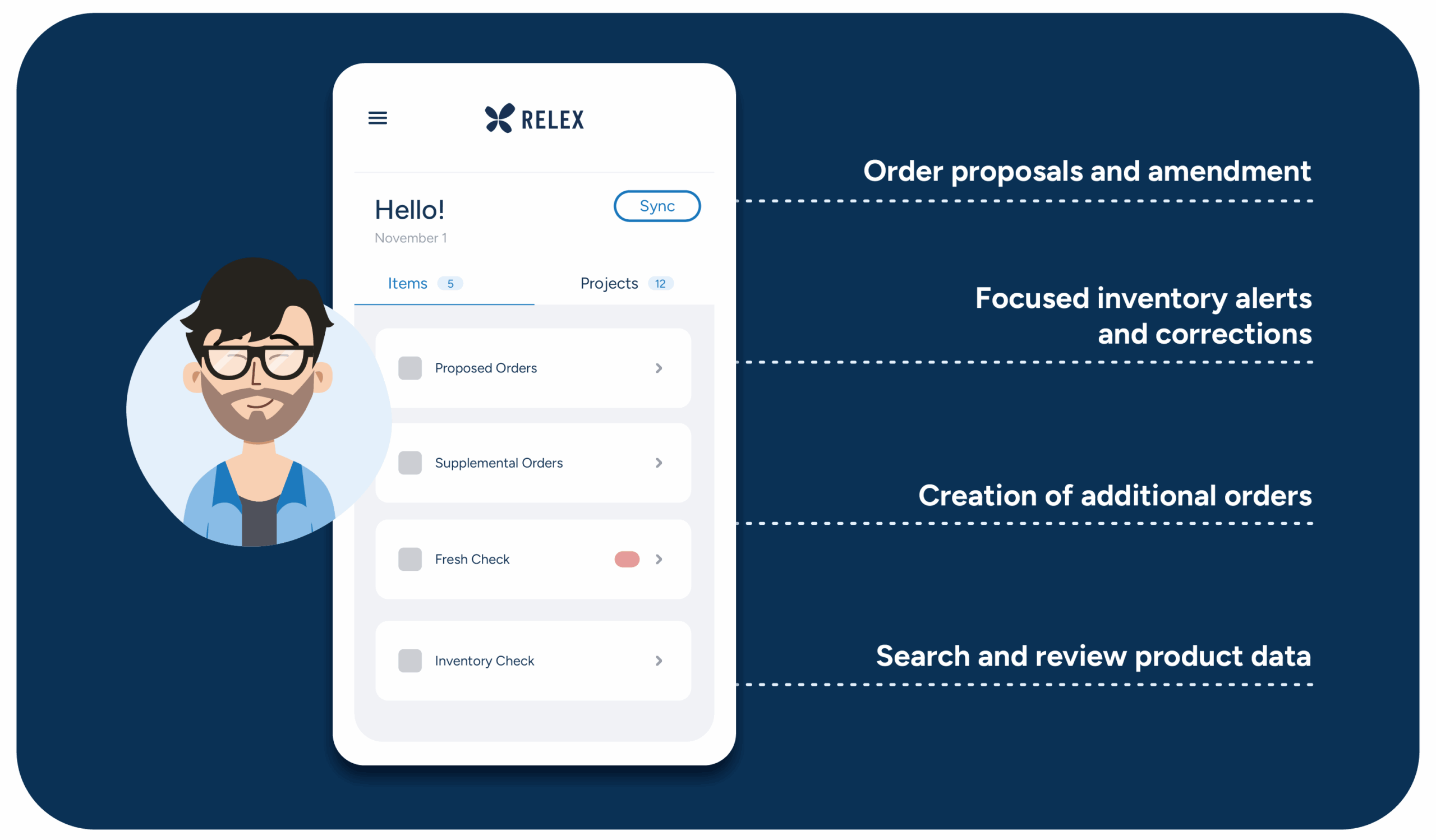
The solution includes AI-assisted ordering capabilities that combine algorithmic recommendations with local knowledge. Store associates can easily adjust orders based on local conditions, special events, or customer feedback while ensuring that their decisions are captured and fed into the system for continual learning.
Near real-time insights enable faster decision-making and better coordination between stores and planning teams. When unexpected situations arise, associates can quickly understand the impact and take appropriate action rather than waiting for guidance from central planning.
Real-world results: Prisma Peremarket
Prisma Peremarket, an Estonian grocery retailer with 13 stores and over 70,000 SKUs, faced significant operational challenges. Uneven delivery patterns throughout the week created bottlenecks that impacted product availability during peak shopping periods.
After implementing RELEX forecasting and replenishment and expanding to capacity optimization capabilities, the results were transformative. Their highest-performing store reduced peak hour deliveries from 31.4% to 22.6% of weekly volume. The strategic realignment enhanced operational efficiency, improved product availability, and delivered a better customer shopping experience while creating more balanced workloads for store personnel.
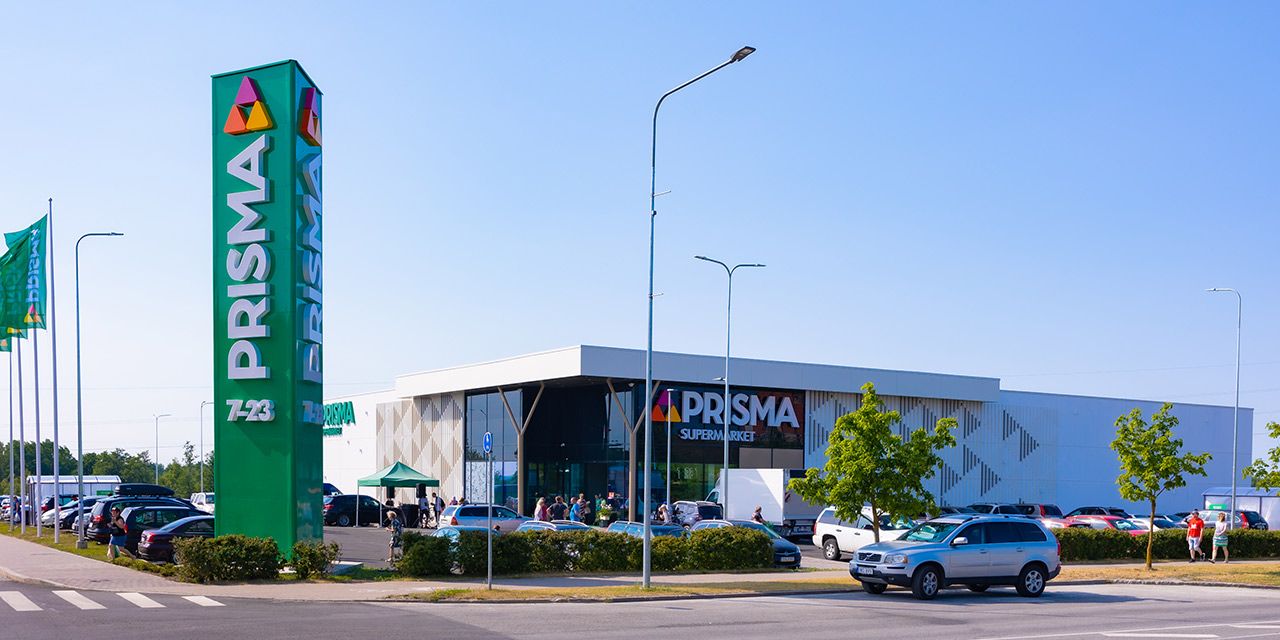
Pain point #5: “The promo went wrong!” – Promotional volatility chaos
A shopper’s experience: Jennifer

“I planned my whole shopping trip around this 40% off promotion, but the shelves were empty except for a few dented cans. After waiting 20 minutes to find out they won’t restock until after the sale ends, I’m wondering why I even bother checking their ads anymore. I checked out another store, and their promotions seem much more reliable.”
Persona spotlight: Demand Forecaster

“Promotions completely throw off our forecast — one bad week can mess up the whole month. We try to adjust based on similar historical promotions, but every promotion is different. Market conditions change, competitive responses vary, and we often don’t get complete information until it’s too late.”
The problem and business impact
Jennifer’s failed shopping trip represents a cascading failure — not just the lost $48 purchase, but the erosion of trust from a customer who spends $180 a week and actively plans around promotions. As with all our other hopeful shoppers, her frustration, shared with neighbors and on social media, influences community perception of the retailer’s reliability while pushing her toward competitors with better execution.
This promotional chaos occurs when traditional forecasting collapses under the pressure of demand spikes that standard models simply can’t predict. When merchandising teams chase maximum impact without considering supply chain constraints and supply chain teams lack visibility into promotional plans and last-minute changes, disaster follows. Weather, competitive responses, and local events compound the volatility.
The result is a lose-lose scenario: over-ordering creates waste and markdowns that destroy margins, while under-ordering generates stockouts that betray customer trust and slash promotional ROI. Each empty promotional shelf plants seeds of doubt — customers question whether the retailer is incompetent or intentionally deceptive, damaging the customer relationship.
RELEX solution: Promotion-aware forecasting
RELEX addresses promotional volatility through AI models that automatically adjust for promotional impacts based on a comprehensive analysis of historical promotional performance, market conditions, and real-time signals. The system doesn’t just recognize that a promotion is planned—it analyzes the promotion’s specific characteristics and compares them to similar historical events to generate accurate demand predictions.
The promotion-aware forecasting capabilities include dynamic adjustments as campaigns progress. If a promotion is performing better or worse than expected, the system automatically adjusts future period forecasts to account for the new information. This enables supply chain teams to respond quickly to promotional success or failure.
Integration with merchandising planning systems ensures that supply chain teams have early visibility into promotional plans and can provide feedback on feasibility and resource requirements before promotions are finalized.
Real-world results: Coop Estonia
Coop Estonia, the country’s largest and oldest retail group, operates a family of 18 consumer cooperatives with more than 300 stores in three different store formats across the country and is owned by some 80,000 customer members. In 2019, Coop Estonia partnered with RELEX to centralize their forecasting and replenishment. In 2022, they expanded the partnership to optimize promotion planning.
Oliver Rist, Coop Estonia Purchasing Director, shares insights about their partnership with RELEX and how they are increasing the profitability of their promotions, optimizing their processes, and securing high availability for campaign products.
Pain point #6: “Waste is hurting us!” – Sustainability and compliance pressure
A shopper’s experience: Tom

“They advertise ‘Zero Waste by 2030’ everywhere, but I watch them throw away perfectly good organic produce and day-old bakery items every time I shop. The gap between their sustainability promises and what actually happens in the store is why I’m taking my business elsewhere.”
Persona spotlight: Director of Sustainability

“We’re under pressure to reduce food waste, and expectations from both regulators and customers are rising fast. We’re making what progress we can, but without systematic tools to optimize ordering and markdowns, we’re falling short of our goals. I know we can do better — and we want to be held accountable.”
The problem and business impact
Tom’s defection signals a growing threat: losing affluent, environmentally conscious consumers who vote with their wallets and amplify their choices online. His social media post about dumpsters full of edible food reached hundreds of like-minded shoppers, creating a reputational crisis.
This waste crisis stems from retailers lacking systematic approaches beyond basic rotation practices. For fresh products, the knife-edge balance seems impossible: over-order and watch profits rot in dumpsters while facing regulatory fines and sustainability backlash; under-order and disappoint customers with empty shelves. Traditional product-by-product management can’t solve systemic issues spanning inventory levels, ordering patterns, and markdown strategies.
The true cost compounds daily: direct losses from discarded products and disposal fees, indirect damage from regulatory compliance failures, and tarnished brand reputation, plus competitive disadvantage as sustainable retailers steal market share. As environmental consciousness drives purchasing decisions, every cart of wasted food pushed to the dumpster pushes environmentally aware, high-value customers to competitors who demonstrate genuine commitment to reducing waste.
RELEX solution: Intelligent forecasting and inventory management
RELEX addresses waste reduction through precise demand forecasting that reduces overstock situations while maintaining high service levels. The system includes shelf-life aware planning capabilities that optimize ordering and rotation based on product expiration dates and expected demand patterns.
The intelligent inventory management approach considers multiple factors simultaneously: demand forecasts, shelf-life constraints, promotional plans, and sustainability goals. This enables retailers to minimize waste while maintaining customer satisfaction and operational efficiency.
Automated reporting capabilities simplify compliance tracking and provide clear visibility into waste reduction progress over time. This enables retailers to demonstrate progress to stakeholders and identify opportunities for continuous improvement.
Real-world results: Oda’s waste reduction
Oda’s sustainability breakthrough demonstrates how intelligent forecasting transforms the painful trade-off between availability and waste into a win-win outcome.
The Norwegian online grocery pioneer leveraged precise demand planning to slash food spoilage by nearly half while maintaining the high availability customers expect from digital retailers. This dramatic achievement proves that operational excellence and environmental responsibility aren’t competing goals—smart technology enables both.
- 49% reduction in spoilage value
- 25% increase in inventory turnover
By cutting spoilage through better forecasting, Oda simultaneously improved sustainability metrics, reduced operational costs, and freed teams to spend 4-5 hours daily on innovation rather than firefighting inventory issues.

The RELEX advantage – Integrated solutions for complex challenges

End-to-end grocery platform
RELEX provides unified control across fresh and center-store categories through a single, integrated platform. This eliminates the silos that traditionally separate different product categories and enables coordinated planning across the entire store footprint.
The single source of truth for all planning decisions ensures consistency and coordination across teams and functions. Marketing, merchandising, supply chain, and store operations all work from the same data and forecasts, eliminating conflicts and miscommunication.
Seamless integration from supplier to shelf enables end-to-end optimization that considers constraints and opportunities across the entire value chain. This systematic approach delivers better results than optimizing individual functions in isolation.

Advanced omnichannel capabilities
Channel-specific forecasting recognizes that online and in-store customers behave differently and generates appropriate demand predictions for each channel. This improves accuracy while enabling channel-specific strategies and promotions.
Virtual ringfencing for optimal allocation ensures that inventory is positioned where it can best serve customer demand and business objectives. The system can protect inventory for high-value customers, upcoming promotions, or critical service level commitments.
Store-level precision for local fulfillment enables retailers to optimize inventory positioning based on local demand patterns and customer preferences. This is particularly valuable for click-and-collect services and local delivery programs.

Mobile-first store operations
Real-time visibility for store teams through mobile devices ensures associates have access to current information wherever they are in the store. This eliminates the need to return to fixed terminals to check system information.
Simplified workflows and decision-making reduce the complexity of daily store operations. Associates can quickly understand what actions they need to take and access the information required to take those actions effectively.
Enhanced collaboration between stores and planning teams creates feedback loops that improve system performance over time. Store associates can provide insights about local conditions and customer preferences that enhance forecasting and planning accuracy.

AI-driven intelligence
Machine learning capabilities continuously improve system performance based on actual outcomes and changing conditions. The AI learns from successes and failures to generate better recommendations over time.
Automated exception handling identifies unusual situations that require attention while allowing routine decisions to proceed automatically. This focuses human attention where it adds the most value while ensuring that urgent issues receive prompt attention.
Predictive insights enable proactive planning that anticipates problems before they occur. Instead of reacting to stockouts or overstocks, teams can take preventive action based on early warning signals.
A proven partner for grocery retail success
RELEX offers grocery retailers a proven path to transformation with measurable results and comprehensive solutions that simultaneously address all major pain points rather than requiring piecemeal improvements over many years.
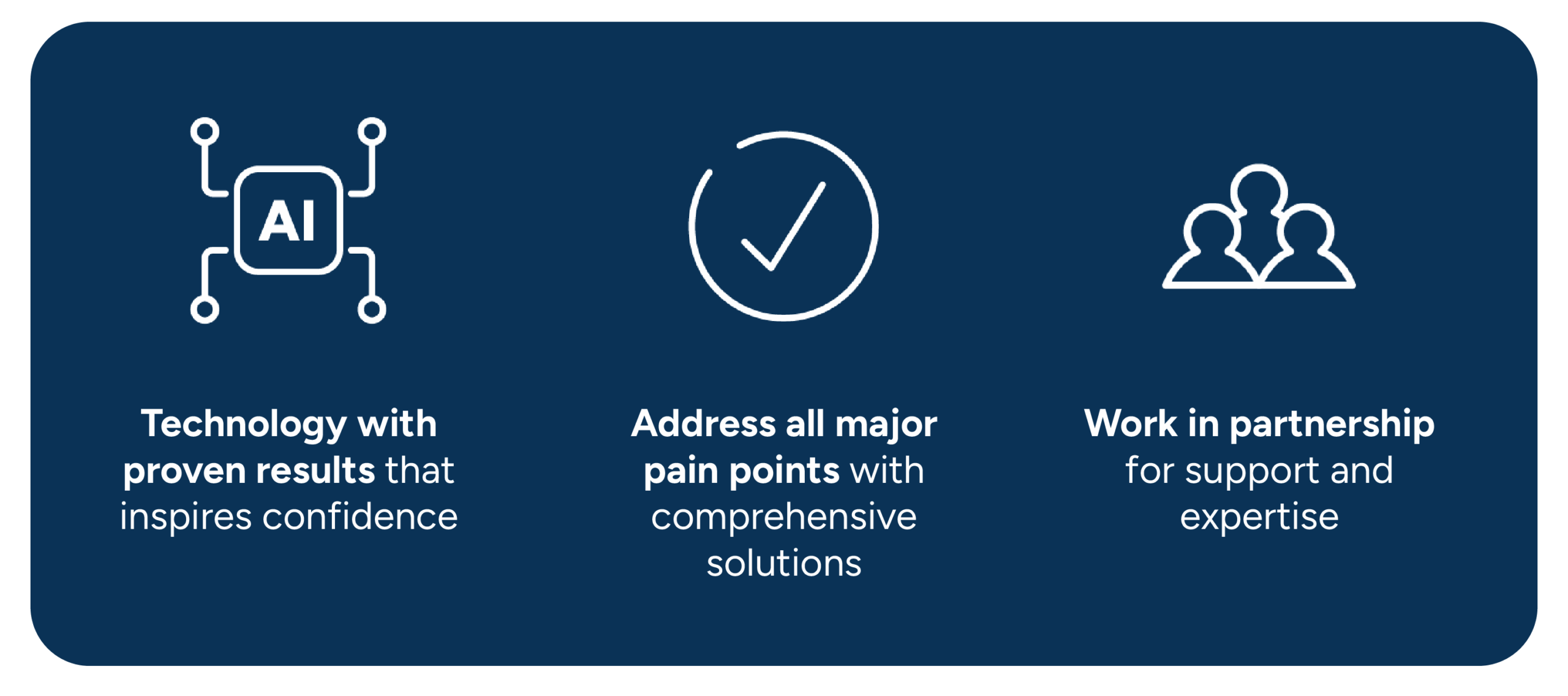
Proven technology with measurable results provides confidence that investments will deliver the promised benefits. RELEX’s successful track record across different types of retailers and markets and 97% retention rate demonstrate the platform’s broad applicability and effectiveness.
A comprehensive solution addressing all pain points enables retailers to transform their end-to-end operations rather than solve individual problems in isolation. This integrated approach delivers synergistic benefits that exceed the sum of individual improvements.
Our partnership approach to transformation ensures retailers receive the support and expertise required for successful implementation and ongoing optimization. RELEX’s experience with hundreds of implementations provides valuable insights and best practices.
The grocery retail industry stands at an inflection point where the companies that embrace integrated, AI-driven operations will pull ahead of those that continue to rely on disconnected, manual processes. The question is not whether transformation is necessary — it’s whether your organization will lead or follow in this evolution.
RELEX has proven that grocery retailers can deliver the seamless customer experiences that today’s shoppers demand while improving operational efficiency and profitability. The technology exists, the results are proven, and the competitive imperative is clear. The only remaining question is when you will begin your transformation journey.



